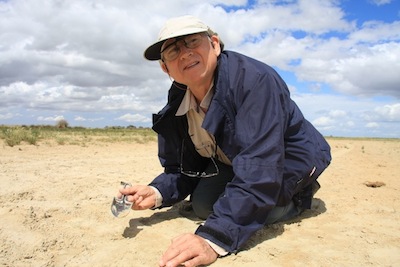Making soil talk: New forensics discipline helps solve major crime

Professor Robert Fitzpatrick, this photo is courtesy of Dr Paul Shand,
CSIRO Land and Water
Tracking down brutal killers and terrorists has never been part of the traditional job profile for people who study soils.
But then Professor Robert Fitzpatrick is not your average pedologist. He's a forensic soil scientist, a term he created to describe exciting new detective work using soil samples to solve serious crime. Give Professor Fitzpatrick and his team at the Adelaide- based Centre for Australian Forensic Soil Science (CAFSS) the tinniest trace of soil on a piece of clothing, for example, and they can deliver investigators critical information. A Professorial Research Fellow at the University of Adelaide's School of Earth and Environmental Sciences, Professor Fitzpatrick has helped pioneer this new forensic science, which has quickly gained acceptance around the world. But he admits it's been a steep learning curve. He's had to build on his normal suite of pedological skills - such as the chemical, physical and biological analysis of soils and minerals - and venture into totally new specialist areas. "Over the past 10 years I've had to become familiar with the intricacies of how forensics work, how the legal system operates and processes such as the chain of custody," he says. "I've also had to learn how to communicate highly technical information to a jury and deal with hostile questioning from courtroom lawyers. "It's tremendously challenging and satisfying to develop new scientific methods or modify existing processes to help police and the justice system to solve complex investigations." Professor Fitzpatrick is now part of the first formal worldwide network of soil and forensic scientists, not only tackling some of Australia's highest profile crimes and cold cases, but using his expertise internationally to support Interpol and counter-terrorism operations. It's been a fascinating journey, which began in 2000 when South Australian police detained Matthew Holding for the murder of his mother and grandmother. Detectives were confident they had their suspect but they needed the bodies to help prove their case. They arrested Holding near Moonta on the Yorke Peninsula and spent three days searching the area after finding a shovel in his car boot. Frustrated at their lack of progress, they took the unusual step of contacting soil scientists at the Commonwealth Scientific and Industrial Research Organisation (CSIRO) where Professor Fitzpatrick worked. While Holding was refusing to talk, the shovel spoke volumes. Analysis back at the laboratory showed that material on the shovel was smeared and compacted in a way that indicated it had been used to excavate and tamp down soil in a wet location. Factors such as the soil's mineralogical composition, acidity, electrical conductivity and salinity were consistent with quarrying in the Adelaide Hills. The correct quarry was identified and the two bodies were ultimately recovered, remarkably within 15 metres of where Professor Fitzpatrick and his team had predicted. Holding subsequently pleaded guilty to the murders and CAFSS was established as a national centre as a direct result of the successful investigation. Since then CAFSS has been involved in more than 130 cases in Australia and overseas, with Professor Fitzpatrick working with Interpol and other agencies as far afield as China, Syria and Africa. The centre has provided soil forensics for many high profile crimes, including the murders of Carly Ryan in South Australia and Corryn Rayney in Western Australia. Professor Fitzpatrick has also been asked to analyse soil on shoes and clothing belonging to several suspected and convicted terrorists from Kenya, Syria, China, Afghanistan and Bosnia. Insightful clues on their overseas travels have been made possible by the discovery of small traces of unique soil types and even pine needles. The identification of gunshot residue in soil located on clothing has also indicated the type of ammunition they may have been using. "We are usually contacted by police for support on serious and scientifically complex cases when their own forensic team is unable to provide the required breakthrough," says Professor Fitzpatrick, who migrated to Australia 34 years ago from his native South Africa. Today he travels the world delivering workshops and training on soil forensics and takes an increasing number of calls from young students interested in pursuing it as a profession. Many are surprised that while forensic soil science is a new discipline, using soil to solve crimes has been around for some time. The difference is that crime agencies have never had access to the same level of specialist scientific expertise offered by CAFSS such as pedology, mineralogy, biogeochemistry and spatial analysis. In the past police laboratories relied mostly on a light microscope to examine soil samples, a technique first documented back in 1856 when a German scientist helped work out which railway station was used during a silver coin heist. The great fictional detective Sherlock Holmes also used the colour and consistency of soils splashed on trousers to identify different parts of London. Professor Fitzpatrick is in good company indeed.
|





